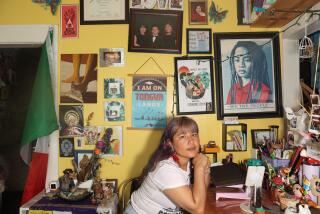Maybe a tweak is all you need
THE newest trend in redecorating is not to.
Instead of calling an interior designer for new things and a new look in your home, call in a quick-fixer to use what’s already there. It’s the low-cost alternative to high-price interior designers, whose bright ideas -- and pricey purchases -- may be out of financial range.
This option may not appeal to people who think they hate what they have. But if they bought it in the first place, maybe they really like it. Maybe all they need is someone like Tara Riceberg, to walk around their house like a medium, and “see” things they can’t.
Riceberg is one of the new breed of “instant decorators” who aim to transform your environment without spending big bucks (maybe no bucks at all) -- by switching, mingling, rearranging -- even scavenging in closets for things you thought you’d never use, but which they may find enormously useful.
Some are one-day decorators who operate long distance. You send a photo of a room that’s in trouble; they tell you by phone or e-mail how to set it right. These are the least expensive services around.
For a fee of $125 per room, for example, New York-based Dial-a-Decorator (owned by Barbara Landsman) counsels on how to enhance your space based on your photos and a description of your taste and needs. At Redecorate.com, a nationwide service, you can sign up for a visit by a local designer, who’ll suggest how to update your decor for about $350 per standard-size room.
More in-depth work is done by those like Riceberg, who’ll recalibrate an entire home in person and on-site for an hourly fee -- and who’ll also do legwork and source-sharing when the case warrants.
Riceberg aims to give a whole new look simply by switching things around, suggesting inexpensive additions such as colorful cushions or curtains -- or even small do-it-yourself projects, such as changing knobs or painting accent trims. She can even make detested elements or areas seem to disappear.
Like the powder-pink tile counters in Gwen Rehnborg’s 1930s kitchen, for example.
“Ugh,” said Rehnborg every time she used to enter the room. But her house is a rental, and there’s no way she and her husband would sink money into changing the countertops, she says.
The couple, both in their mid-30s, also decided not to buy new furniture for the place, because they’re not sure how long they’ll stay. “We’ll be here a while, but what we buy for this house may not be right for the place we eventually settle into,” Rehnborg says.
Their home is filled with items acquired when they were singles traveling the world, then in Boston where they met, and in New York where they married. They stuffed it all into the Santa Monica condo they bought as newlyweds, where their first child was born.
With a second child on the way, they sold the too-small condo and rented the 1,700-square-foot house with hardwood floors on a leafy Santa Monica street. With its comfortable country look and big backyard, it seemed a great place to nest. Trouble was, no matter how Rehnborg arranged and rearranged their possessions, the house felt cold and unwelcoming instead of cozy and warm.
“Something wasn’t right; I didn’t know what,” says Rehnborg, who is director of the Nutrilite Health Institute.
“What I needed was a new set of eyes; I’d stopped seeing possibilities.”
She read about Riceberg in the online tip sheet, Daily Candy, and arranged a one-hour consultation at $250. “I had no great expectations,” Rehnborg says. “I figured it was worth a try.”
Riceberg, 37, walked around the house with her new client. “She tossed out a bunch of ideas,” Rehnborg says. “Didn’t touch or move anything, just kept coming up with really solid suggestions. It wasn’t until halfway through that I thought to pull out a pen and write things down.”
The cream-colored living room, for example, had unmatched facing sofas, with a bare coffee table in between. Two cabinets and a bench sat at the far end near the fireplace, its mantel adorned with a Larry Bell painting. Blah and bland, the room seemed more suited to a therapy session than an evening with friends.
The kids’ room is large enough to double as a playroom for the couple’s now 2- and 5-year-olds. Rehnborg put cushy area rugs on the floor, but “for some reason they still don’t want to play there,” she said.
A large bathroom mirror with an ornate white frame looked like a Tony Duquette reject. It came with the house, Rehnborg said, pronouncing it ugly. The white kitchen, with its gingerbread woodwork and pink tiles, was in her view, “a mess.”
But Riceberg, who calls her firm Twe-k, saw huge potential. She appreciated the couple’s eclectic possessions. “Even if I didn’t, I’d never criticize what people own, because it’s a reflection of who they are. Nor do I impose my own personal style. Why emulate me or anyone else?” By the consultation’s end, Rehnborg felt hopeful and decided to try some suggested tweaks.
First, she tackled the children’s room, putting down fine wool wall-to-wall carpet. It was the most costly idea ($500), but what a payoff, she says. “I was amazed. It totally changed the way we use the room. Now, we’re always on the floor playing games, having fun. It’s soft and nice. Such a really simple solution. But it just hadn’t occurred to us.”
It took another consultation (at $125 an hour) to get the rest of the house going. Riceberg arrived with new ideas, catalogs full of good design at low prices and an endless amount of positive energy.
She took two small chairs from the bedroom and placed them near the living room fireplace where the bench had been. She had a colorful cushion made for the bench and placed it at the room’s entry, where it became a handsome focal point.
Rehnborg, who had been a relief worker in Somalia, had lots of beautiful hand-woven fabric from there, which Riceberg found languishing on a closet shelf.
She suggested making an artwork for the living room: three small hand-woven swatches, stitched to a canvas painted burnt orange. It now hangs above one sofa. More of the fabric covers the front of a large pillow made for the facing sofa. (Both pillows for the living room totaled $210.) She switched the cabinets to opposite sides, and used more fabric as a curtain to hide items stored on the shelves of one.
The painting over the mantel was moved to a built-in alcove, from which shelves were removed. Rehnborg painted the alcove dark chocolate brown on her tweaker’s advice. It’s the accent shade they decided to use throughout the house for emphasis and unity.
The dark wood coffee table was enlivened by two elongated woven baskets filled with plants ($300), which Riceberg put together herself. “The baskets are expensive, but beautiful. They’re handmade woven rattan and wood,” Rehnborg says. The tweaker found two old copper bowls in Rehnborg’s cupboard, turned one upside down and stacked the other one on top of it.
The resulting “sculpture” now graces the mantel where the painting used to be. The addition of plants in decorative containers (three cost $100), and two “pot lights” that sit on the floor behind the plants ($10 each at Home Depot) are another warming touch.
“Most people are so hemmed in by definitions of things that they can’t see beyond the definition to a more creative approach,” says Riceberg, who honed her talents working at her mother’s home accessories shop, Tesoro, first located in Beverly Hills and then in West Hollywood.
“People started asking me to come to their homes and tell them what to do with what they had. And what little things they could add from the shop to make it all look more interesting,” says Riceberg, who closed the West Hollywood store last year. She knew then she had a marketable talent for something she enjoyed, and abandoned plans for law school.
Riceberg says she’s always been blessed with “a kind of vision.” Ice tongs become asparagus servers, champagne buckets become wastebaskets in a powder room. A $40 ceiling fan from Home Depot could become a work of art if the ho-hum light-bulb shades are replaced with delicate glass beauties from the Rejuvenation catalog. (Rehnborg hasn’t tackled that suggestion yet. The art glass shades are a bit pricey, and she’s not sure they’ll want to use the fan in their next place.)
The offensive pink tiles in the kitchen were just one of the room’s problems. A modern table and matching chairs didn’t blend with the graceless shades that inadequately covered the corner of windows facing the street. Combined with unattractive old pulls on cabinets and passe ceiling fixtures -- nothing went together, and none of it worked.
Riceberg did some legwork (at her usual hourly fee). She found multicolor striped curtains on sale at the Silk Trading Co., and used them, floor to ceiling, to cover the corner windows (three panels, $300). They instantly changed the look of the room.
The pink stripe in the curtains picked up the countertop color, but the red and other bright stripes seemed to also make it disappear. Rehnborg is now able to display her favorite bright red modern toaster, which matches the curtain’s red stripes -- and which suddenly looks tres chic sitting on pink tile.
Following other suggestions, Rehnborg spray-painted the kitchen table-frame dark brown, and ordered four bentwood dark brown chairs ($360 for the set) from the West Elm catalog. She changed 32 kitchen cabinet knobs to dark brown (at $4 each). They blend well with the pink tile, the stripes, and the two sleek new chrome-wrapped ceiling fixtures ($120 each) Riceberg found. The kitchen now has pizazz.
The ornate bathroom mirror-frame was spray-painted dark brown and hangs in the hallway now -- the first thing a visitor sees when the front door opens. Suddenly stunning, the mirror and its matching shelf personify the hidden assets that lurked everywhere inside, waiting to be rediscovered.
Rehnborg’s delighted. She loves the look of the living room, now an inviting and integrated space. The total cost of the updates so far is about $2,000, she says, including chairs, carpet, curtains, plants, pillows, spray-paints and kitchen knobs, but not hourly fees. She plans to continue using Twe-k’s services.
Riceberg likens her work to “a style injection for the house -- it’s like doing Botox instead of plastic surgery.”
Rehnborg prefers her own fitness analogy: “Tara’s more like a personal trainer. She takes what you have and tightens it up, makes it look great. Best of all, by using what my husband and I had, she allowed us to emerge, and all our stories to be told.”
Bettijane Levine can be reached at bettijane.levine@latimes.com


